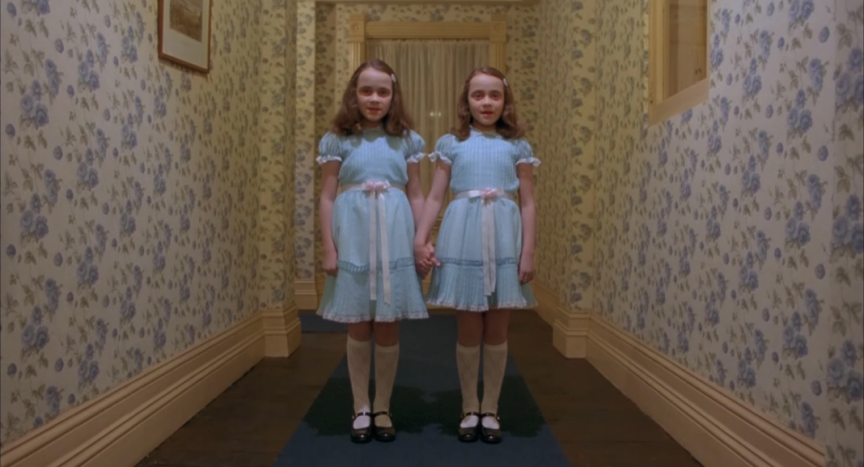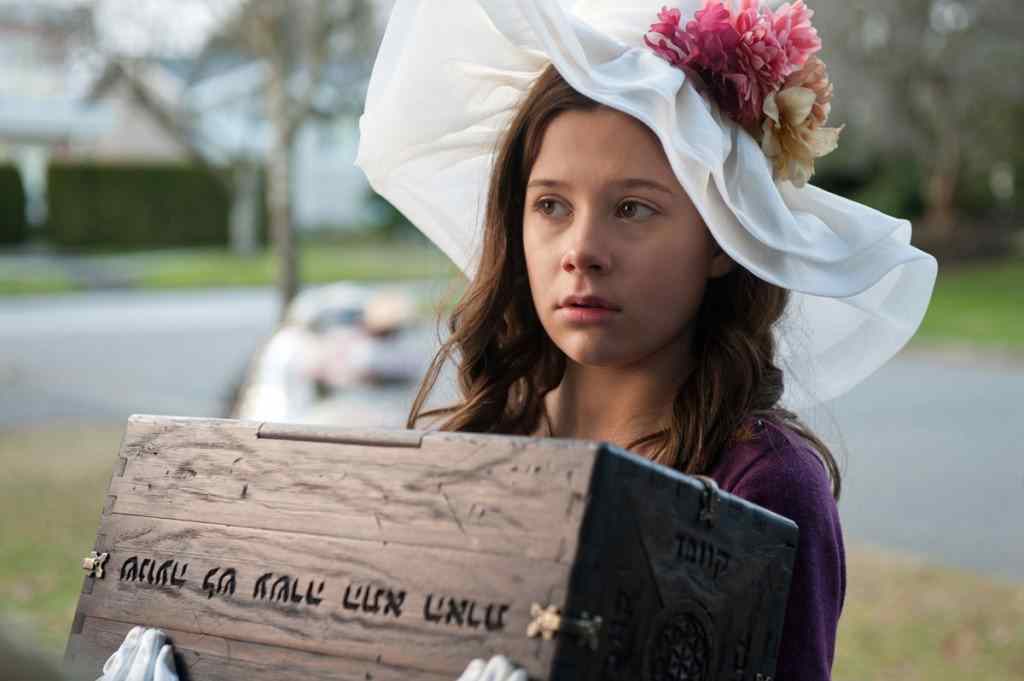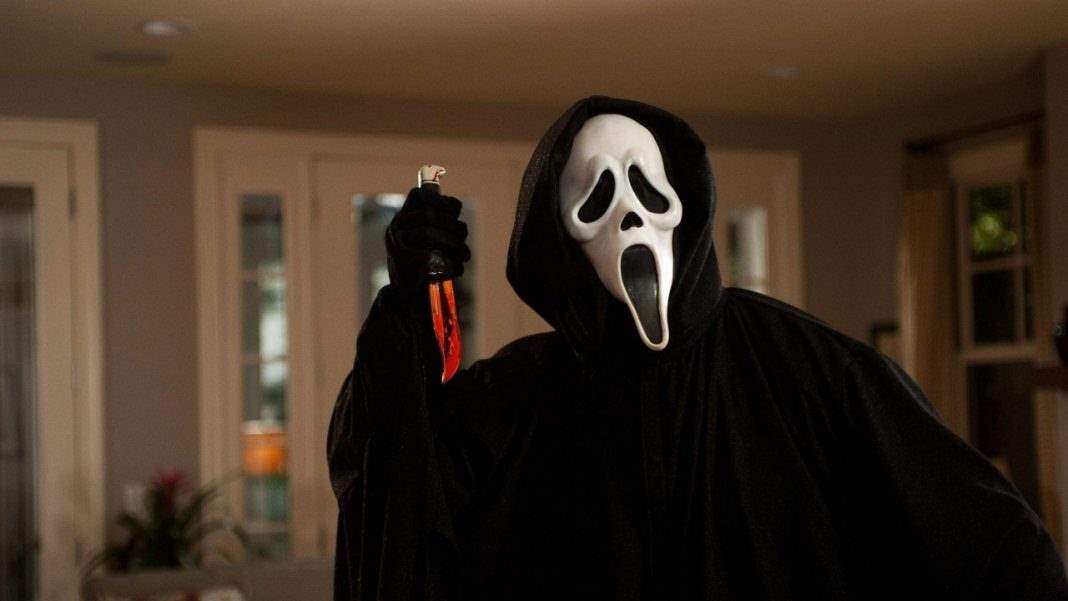One trick that’s often used in horror movies is claiming that they’re based on real events that have happened. Here we list some of the real scary stories that have been turned into movies. Read more below and let us know your thoughts in the comments box provided below!
THE SHINING-
Let’s start with a horror classic and one of my favorite films of all time; The Shining.
Not actually many people know that this famous film, directed by Stanley Kubrick, are based on events that happened to the novelist, Mr. Stephen King himself, after staying at The Stanley Hotel in Estes Park, Colorado.
King and his wife Tabitha spent an evening at this hotel that, that at the time, was eerily empty. King has previously stated that when he and his wife arrived the hotel was getting ready to close for the season and they found themselves the only guests in the place with all these long, creepy, empty corridors. King has explained that after dinner and later that evening he had dreamt of his three year old son running through those corridors, looking back over his shoulder with his eyes wide and screaming. He said that saw he was being chased by a fire-hose and King woke up with a tremendous jerk, sweating all over and an inch from falling out of bed.
King had got up and lit a cigarette, sitting in a chair looking out the window. By the time the cigarette was done King had the bones of the book firmly set in his mind.
At busier times many people have reported witnessing strange activity in the hotel. The majority of sightings were reported in the large ballroom where kitchen workers at the hotel heard loud music, dancing, and conversation in the ballroom, only to find nothing. Sound like a film you know?
Parts of the television mini-series version of The Shining were actually filmed at The Stanley Hotel, while (quite ironically given the name) Stanley Kubrick’s cinematic adaptation of The Shining was shot almost entirely in a studio at Elstree Studios in Hertfordshire, England. The exterior shots of “The Overlook Hotel” being from The Timberline Lodge in Oregon.
The Stanley Hotel also shows the uncut R-rated version of Kubrick’s feature film on a continuous loop on Channel 42 on guest room televisions.
THE POSSESSION-
I saw the real dybbuk (or dibbuk) box documentary and it was chilling, creepy and awesome, a real scary story. The possession movie, directed by Ole Bornedal didn’t show half as much havoc as the box caused but I did enjoy it all the same.
Kevin Mannis, a writer and creative professional by trade, owned a small antiques and furniture business in Portland, Oregon. According to Mannis’ story, he had bought the box at an estate sale in 2001. It had belonged to a Holocaust survivor of Polish origin, named Havela. At the estate sale, the woman’s granddaughter, upon noticing that Mannis had picked up the Dybbuk box, explained how her grandmother insisted that the box never be opened, stating she had purposely sealed a dybbuk inside it after performing a séance on a homemade oracle board.
Buying the box Mannis brought the cabinet back to his small furniture store, where he stowed it in the basement and left, leaving a young sales clerk in charge of the shop. About a half hour later, the saleswoman called absolutely hysterical and screaming that someone was in the workshop breaking glass and she couldn’t get out of the emergency exit or iron security gate. As Mannis tried to call the police his phone went dead. Rushing over to his workshop he found his employee on the floor in a corner of his office, sobbing hysterically. In the basement Mannis was hit by an overpowering unmistakable odor of cat urine although no animals had ever been kept or found in the shop. The lights didn’t work and each and every bulb was broken though no intruder was never found. His sales assistant never returned to work after having worked for Mannis for two years and refuses to discuss the incident to this day.
Upon opening the box, Mannis found that it contained two 1920s pennies, a lock of blonde hair bound with cord, a lock of dark hair bound with cord, a small statue engraved with the Hebrew word “Shalom”. One dried rose bud, a single candle holder with four octopus-shaped legs, and a small, golden wine goblet.
Not thinking too much about the box, Mannis gave it to his mother for her birthday. While she examined it at his shop, Mannis went to make a phone call and hadn’t been out of sight for more than five minutes when one of his employees came running into his office saying that something was wrong with his mom. Upon seeing what was up, he found his mom sitting in a chair beside the cabinet. Her face had no expression, but tears were streaming down her cheeks. No matter how much Mannis tried to get her to respond, she couldn’t. It turns out that the mother had suffered a stroke.
After unsuccessfully trying to give it away only to get it back, reluctantly, he took the box home and began having a recurring nightmare involving “the most gruesome, demonic-looking hag that I have ever seen.” Following a number of disturbing events Mannis listed the box on eBay, where it was purchased by bidder “agetron”, who then sold it again. The box shifted ownership through a number of other transactions before it eventually ended in the arms of Jason Haxton. Jason was the director of the Museum of Osteopathic Medicine in Kirksville, Missouri and had been following blogs regarding the box and bought it for $280. Haxton wrote The Dibbuk Box, and claimed that he subsequently developed strange health problems, including hives, coughing up blood and head-to-toe welts while his wife experienced bloody, weeping blisters. After Haxton’s office experienced the bursting of light bulbs he locked the box in the back of his truck, parking it at his home in the evening. Haxton then began experiencing nightmares of hag-like women, not unlike Mannis’ claims. The final straw, Haxton claims, happened while he and his son were watching television and his son noticed a black flame-like mass in the room with them.
Haxton consulted with a Rabbi to try to figure out a way to seal the dybbuk in the box again. This was apparently successful and Haxton took the freshly resealed box and hid it at a secret location, which he will not reveal. Stating that when he dies he “would like the dybbuk box to be buried with me and for it to be finally gone from this world.”
THE EXORCISM OF EMILY ROSE-
One film many horror fans have seen and know of, but not many know of the actual girl it’s based around.
The Exorcism of Emily Rose, directed by one of my favorites, Scott Derrickson, is a story based on the life of Anneliese Michel, born September 13th, 1952 in Leiblfing, West Germany. Throughout her childhood, Anneliese was a regular Catholic girl who enjoyed the company of her peers. Her life changed one day in 1968 when she began shaking and found she was unable to control her body. She could not call out for her parents, Josef and Anna, or any of her 3 sisters. A neurologist at the Psychiatric Clinic Wurzburg diagnosed her with epilepsy and because of the strength of fits, and the severity of the depression that soon followed, Anneliese was admitted for treatment at the hospital.
Soon after the attacks started, Anneliese began seeing devilish grimaces during her daily praying. Voices also began following her, saying Anneliese will “stew in hell” and she began convinced she was possessed. She had mentioned the “demons” to her doctors only once, explaining that they have started to give her orders. The doctors seemed unable to help or console her fears in any way, and Anneliese lost hope that medicine was going to be able to cure her.
In the summer of 1973, her parents visited different pastors to request an exorcism. Their requests were rejected and they were given recommendations that the now 20 year old Anneliese should continue with medication and treatment. It was explained that a Bishop cannot approve an exorcism until all the requirements are met by an individual, including an aversion to religious objects, speaking in a language the person has never learned, and supernatural powers.
In 1974, after supervising Anneliese for some time, Pastor Ernst Alt requested a permit to perform the exorcism from the Bishop of Wurzburg, which again was rejected. Anneliese’s attacks did not diminish at any point and her behavior become more erratic. At her parents’ house in Klingenberg, she insulted, beat, and began biting the other members of her family. She refused to eat because the demons would not allow it but ate spiders, flies, and coal, and even began drinking her own urine and sleeping on a cold stone floor. She could be heard screaming throughout the house for hours while breaking crucifixes, destroying paintings of Jesus, and pulling apart rosaries.
After making an exact verification of possession in September 1975, the Bishop of Wurzburg, Josef Stangl, assigned Father Arnold Renz and Pastor Ernst Alt with the order to perform “The Great Exorcism” on Anneliese Michel. It was determined that Anneliese must be saved from the possession by several demons, including Lucifer, Judas Iscariot, Nero, Cain, Hitler, and Fleischmann; a disgraced Frankish Priest from the 16th century, and some other damned souls which had manifested through her. From September 1975 until July 1976, one or two exorcism sessions were held each week but Anneliese’s attacks were sometimes so strong that she would have to be held down by at least 3 men, or even be chained up. For several weeks, Anneliese denied all food. Her knees ruptured due to the 600+ genuflections she performed obsessively during the daily exorcism.
The last day of the Exorcism Rite was on June 30th, 1976, when Anneliese was suffering at this point from Pneumonia. She was also totally emaciated, and running a high fever. Anna Michel recorded the death of her daughter on the following day, July 1st, 1976, and at noon, Pastor Ernst Alt informed the authorities in Aschaffenburg. The senior prosecutor began investigating immediately.
According the forensic evidence, “Anneliese starved to death”. Specialists claimed that if the accused would have begun with forced feeding one week before her death, Anneliese’s life would have been saved. The exorcists tried to prove the presence of the demons, playing taped recordings of strange dialogues like that of two demons arguing about which one of them would have to leave Anneliese’s body first. Not one of those present during the exorcism ever had a doubt about the authenticity of the presence of these demons.
Anneliese’s parents, as well as the exorcists, were found guilty of manslaughter resulting from negligence and omitting first aid. They were sentenced to 6 months in jail and probation. The jail sentence was later suspended.
THE GIRL NEXT DOOR/AN AMERICAN CRIME-
The real scary story of how some people just have no compassion.
The Girl Next Door (2007) based on the Jack Ketchum novel, directed by Gregory M. Wilson, and An American Crime (2007) written and directed by Tommy O’Haver are both based around the same true story.
The story is that of Sylvia Likens, the daughter of two carnival employees who, in 1965, along with her younger sister Jenny, were placed in the care of Gertrude Baniszewski in exchange for $20 a week by their father Lester. Their mother Betty was arrested and jailed for shoplifting shortly before this.
Gertrude wasn’t in the best health, suffering from depression and the stress of several failed marriages with seven dependents of her own. She began to snap, taking out her frustrations on the Likens girls. It started with spanking and beating the girls with paddles, gradually increasing in severity, reaching a point where Sylvia was forced to eat her own vomit at the dinner table as punishment for overeating at a church picnic.
Sylvia was accused of spreading rumors that Paula and Stephanie, daughters of Gertrude, were prostitutes, and this supposedly provoked Stephanie’s boyfriend, Coy Hubbard, to physically attack Sylvia. Gertrude had encouraged Hubbard and other neighborhood children to torment the poor Liken girl, including extinguishing cigarettes on her skin and forcing her to remove her clothes and insert a glass bottle into her vagina on at least two occasions. Among other disgusting and degraded things.
Likens became incontinent, urinating in her bed, and as a result, Gertrude locked her in the basement, keeping her out of school and forbidding her to use the toilet. Gertrude then began a bathing regime to “cleanse” Sylvia, involving dousing her with scalding water and rubbing salt into the burns. She was often kept naked and rarely fed, sometimes being made to consume her own feces.
Jenny Likens managed to contact her older sister, Diana, outlining the intense trauma and asked Diana to contact the police. Diana ignored the letter, believing that Jenny was simply making up stories so that she could come live with her, but came by to visit the sisters unexpectedly one day. Gertrude refused to allow her into the home stating that Sylvia had ran away. Concerned, Diana Likens contacted social services but when a social services worker showed up at the Baniszewski home inquiring about Sylvia, Gertrude made Jenny lie to them, threatening her that if she did not, she would get the same treatment as Sylvia. Terrified of what Gertrude might do to her Jenny lied and told the social services worker that Sylvia had indeed run away. The social services worker returned to her office, where she filed a report stating that no more follow-up visits needed to be made to the Baniszewski home.
Sylvia was brutally tortured, mutilated, and humiliated for months at the hands of her Getrude who was supposed to be her caregiver.
Gertrude had her children bring Sylvia up from the basement and tie her to a bed. The next morning, Gertrude was enraged that Sylvia had wet herself during the night, and again forced her to insert a Coke bottle into her vagina, before beginning to carve the phrase “I’m a prostitute and proud of it” into her abdomen with a hot sewing needle. Ten-year old Shirley Baniszewski used a heated eye bolt to burn the number 3 into Sylvia’s chest at the same time. That next day Gertrude woke Sylvia, dictating a letter to her, intending it to look like a runaway letter to her parents.
When Sylvia overheard plans of Gertrude intending to have her thrown at a dump and left to die, she attempted to escape, but was stopped by Gertrude who pulled her back inside the house and again threw her down the basement steps and kept her there.
On October 26, 1965, after multiple beatings, burnings, and scalding baths, Sylvia Marie Likens died of a brain hemorrhage, shock and malnutrition. She was just 16 years old.
Gertrude Baniszewski was found guilty of murder in the first degree. She was sentenced to life imprisonment. After a re-trial and being given the same sentence, Baniszewski became a model prisoner, working in the sewing shop and becoming a den-mother to younger female inmates. By the time she came up for parole in 1985, she was known by the prison nickname “Mom”.
The Parole board voted in favor of granting Gertrude’s freedom 3-2 and Gertrude Baniszewski walked out of prison on December 4, 1985, and traveled to Iowa, where she called herself Nadine Van Fossan, using her middle name and maiden name. She died in Laurel, Iowa, from lung cancer, on June 16, 1990, aged 60.
THE HAUNTING IN CONNECTICUT-
Another movie that I saw the real documentary on, The Haunting in Connecticut, directed by Peter Cornwell.
The Snedeker family had the ideal life in upstate New York when son Philip, 13, was diagnosed with Hodgkin’s lymphoma. The closest facility capable of treating childhood cancers was in Hartford, Connecticut and they began making the 300-mile round-trip five times a week for Philip’s treatment. The radiation treatment burned his skin from the inside and Carmen was afraid that the trips would kill her son as fast as the cancer, so the family decided they had to move to Connecticut.
After finally hearing of a townhouse that they could rent, sight unseen, Carmen took it.
Upon moving in, the house looked perfectly normal, but it wasn’t. Above every doorway was a crucifix and they soon found out that it was once funeral home with the basement still housing some of the mortuary equipment used to prepare the bodies for burial. Not wanting to stay there but not having much choice, Alan returned to New York to work, leaving Carmen to get the house and all four kids settled.
Philip’s room resided in the basement as it was close to a bathroom for his recurring nausea, and she could easily hear if he needed help. The very first night in the house, Philip was awakened by someone saying his name. He went to Carmen, who had been on the phone with Alan. She reassured her son that with the way sound travels in an empty house, he had to have heard her talking to his father but Philip was already convinced that the house was evil, and wanted them to leave. A few days later Carmen noticed that the crucifix above the door, in what would have been the morgue, had disappeared, yet the nail that had held it was undisturbed.
Philip shared the room downstairs with his brother, Brad, and one night, they both saw four figures standing in the corner near Brad’s toy robot. The toy was going crazy and all four figures turned as one and looked at the boys, making them sprint up the stairs to Carmen both terrified. Carmen headed down to investigate while the boys were still beside her, scared to death and went through the entire basement but found nothing. Walking back up to the kitchen she discovered the crucifix over the door was now gone too.
One day Philip moved his bed into the embalming room, claiming he had “made a deal” which frightened a Catholic Carmen. Philip was also becoming more withdrawn and rarely smiled, feigning no interest like he normally would when his cousins Kim and Tammy Alvis came to visit.
Tammy was helping Carmen clean the house one afternoon and upon tidying Philip’s room had found the journal he had started to keep. She didn’t want to invade Philip’s privacy, but she was worried, and gave the journal to Carmen. The pages were very dark, full of notes about death, murder, and killing. Something struck Carmen as odd as her oldest son was dyslexic. She had spent years trying to get him to properly write the alphabet, and here were complex words perfectly written. When she asked her son, Philip replied that “the man” helped him write.
After a few more incidents and accusations from the other children in the house about Philip scaring them, Carmen called her son’s doctor, explaining what was going on. The doctor replied that she was describing schizophrenia, and began the process of having Philip committed. That night at dinner, Carmen did her best to pretend everything was fine. She even made Philip’s favorite dinner, but the men in white didn’t even knock. They just walked into the house and carried Philip out.
Carmen had wanted to believe Philip, but every time she had investigated Philip’s stories, she hadn’t been able to prove any of it. As they put the straight-jacket on her son, Philip told her that now that he was gone, they were going to come after her. Carmen did not want to believe her son would be a schizophrenic for the rest of his life so she went and sat on the stairs to Philip’s room, daring “the man” to come play with her. She sat there for hours, and nothing ever appeared. But one day when she was taking a shower, Carmen was enveloped in the shower curtain. It was tight around her face, slowly smothering her, and she couldn’t push it away. Calling for Tammy, Tammy was able to rip a hole in the curtain so her aunt could breathe. It became apparent in that moment that Philip’s prediction was coming true. After Tammy had awoke, troubled and frightened in the middle of the night, running to Carmen’s room, Carmen grabbed her Bible and noticed on her way out of her bedroom that the last crucifix in the house, the one over her bedroom door, had disappeared.
An exorcism was performed on the house after Ed and Lorraine Warren (also mentioned in The Conjuring) investigated the house and proclaimed the Snedeker house to be infested with demons. The Snedekers moved out. Racked with guilt over what she’d done to her son, Carmen got Philip out of the mental hospital. In a later interview Philip said he understood that his mother was trying to be strong but that he had felt betrayed by what she’d done.
After 24 years, Philip’s cancer returned. He died in January of 2012.










